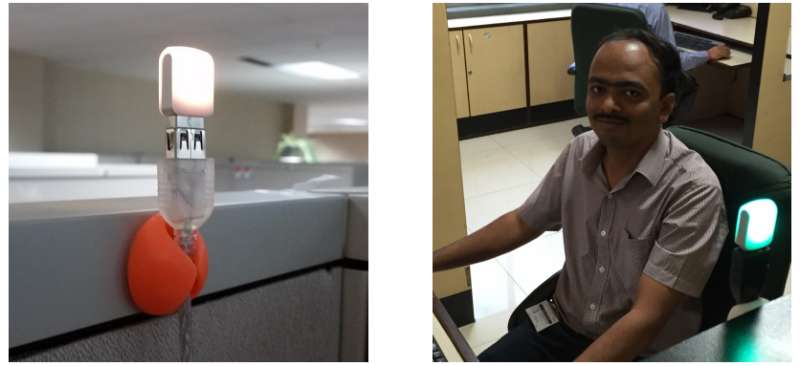FlowLight. Credit: "Reducing Interruptions at Work: A Large-Scale Field Study of FlowLight"
(Tech Xplore)—The big threat to putting in a satisfying day's work is quite simply interruptions. How was your weekend? So did you ever get the boat to run? Who do you think will win tonight? Cubicles, open floor plans, those "team nurturing" work spaces, do not help.
A recent column about interruptions at work on Jacksonville.com can resonate with any knowledge worker trying to meet a deadline. "For a while, two of my staff were housed in cubicles with no front wall barriers. They called their space the Petting Zoo, since everyone who walked by felt they had to say something. Some even stopped for a social conversation, despite strong 'I'm busy' body language."
The column also said studies have shown that even tiny interruptions in concentration "can cost up to 20 minutes of time before a worker can regain full focus and productivity; flow can be elusive."
Well, there are ideas on how to address interruptions, and New Scientist recently looked at a technology solution—a traffic light system that you can mount on your wall and it measures how busy you are. The system is called FlowLight. It sends corresponding color signals to let others know they should stay away from your office or workspace or feel free to stop in.
The system uses the phrase "traffic lights" and that is how it communicates the person is busy or not. The LED light changes colors depending on your status and, as you may have guessed, red means busy.
The colors actually indicate four states: Available as green, Busy as red, Do Not Disturb as pulsating red,and Away as yellow.
Overall, the application is compatible with the Windows operating system, Skype for Business, and Office 365.
How do the lights know if the worker is or is not too busy to be interrupted? Movement is tracked via mouse and keyboard.
Matt Reynolds talked about this in New Scientist: "The FlowLight system tracks keyboard strokes as well as mouse clicks and movement," he said. "If a person's combined keyboard and mouse activity is within the top 9 per cent of their average activity range, then an LED attached to their desk glows red, warning colleagues not to bother them."
There is a status manager, for notifying of any change in the user's interruptibility; it propagates the updated status to the LED light and user's presence status in Skype for Business.
The team behind the system wrote a paper describing their work. "Reducing Interruptions at Work: A Large-Scale Field Study of FlowLight" is by Manuela Zuger, Christopher Corley, Andre Meyer, Boyang Li ,Thomas Fritz, David Shepherd,Vinay Augustine, Patrick Francis, Nicholas Kraft, and Will Snipes.
Conceived by David Shepherd, lead software engineering researcher for ABB, he wanted to reduce the number of interruptions in a work day and he had in mind keeping software engineers on track, (one example of workers who need to keep focus in completing tasks).
He received help from a team at the University of Zurich in Switzerland to carry this through. The authors said the system "combines a physical traffic-light like LED with an automatic interruptibility measure based on computer interaction data."
They carried out a study involving 449 workers in 12 countries to evaluate the potential of FlowLight.
Results? Using the device cut interruptions by 46 percent. In other words, the authors found that those who used the system experienced 46 percent less interruptions.
More information: Research paper: Reducing Interruptions at Work: A Large-Scale Field Study of FlowLight (PDF)
© 2017 Tech Xplore





















